Discover The Factors Causing Water Seepage in Your Home
Discover The Factors Causing Water Seepage in Your Home
Blog Article
We've unearthed this article about How to detect water leaks in your home down the page on the internet and concluded it made sense to talk about it with you on my blog.

Leaks not just trigger waste of water yet can additionally cause unneeded damage to your residence and promote undesirable natural growth. By understanding and also looking for everyday circumstances that trigger leakages, you can safeguard your house from future leaks and unneeded damage.
Intruding origins
Many water leakages begin outside your house instead of inside it. If you notice an unexpected decrease in water pressure, say in your tap, take some time to head out and also examine your backyard. You could notice damp patches or sinkholes in your backyard, which may suggest that tree origins are attacking water lines creating water to seep out. You can have your plumber check for invasion, specifically if you have trees or shrubs near your property.
Rusty water systems
As time goes by, your plumbing system ages and also corrosion such as corrosion may begin eating away the pipelines. This could be the root cause of staining or bending on your pipes. This requires an evaluation with your plumber quickly. Consider changing the pipes because they are at a higher threat of corrosion than the newer designs if our plumbing system is old.
Defective Pipe Joints
Pipe joints can degrade over time, resulting in water leakages. If you have loud pipelines that make ticking or banging noises, particularly when the warm water is transformed on, your pipeline joints are possibly under a whole lot of stress.
Instantaneous temperature level changes.
Severe temperature changes in our pipes can cause them to increase and also acquire suddenly. This growth and contraction might create fractures in the pipes, specifically if the temperature level are below freezing. If you kept an eye on how your plumbing functions, it would be best. The visibility of the previously stated situations frequently shows a high danger.
Poor Water Connectors
Sometimes, a leak can be caused by loosened hose pipes and pipelines that supply your devices. Typically, changing is what causes the loosened water Connections. You might find when it comes to a cleaning maker, a pipe might spring a leak due to shaking throughout the spin cycle. In case of a water links leak, you might see water running straight from the supply line or pools around your home appliances.
Blocked Drains
Obstructed drains pipes could be annoying as well as inconveniencing, yet they can often end up triggering an overflow bring about burst pipelines. Maintain removing any materials that may go down your drains pipes that can obstruct them to stay clear of such hassles.
All the above are sources of leaks yet not all water leakages result from plumbing leakages; some leakages might come from roofing leakages. All leaks must be fixed immediately to prevent water damage.
Leaks not only create waste of water however can also create unnecessary damage to your residence as well as advertise undesirable natural growth. By recognizing and looking for everyday situations that create leakages, you can safeguard your residence from future leakages and unnecessary damages. Today, we will certainly look at six leakage causes that may be triggering your pipelines to drip.
At times, a leakage can be created by loose hoses as well as pipelines that provide your home appliances. In situation of a water connections leak, you might observe water running straight from the supply line or puddles around your devices.
How To Check For Water Leak In Your Home
How To Check for Leaks
The average household's leaks can account for nearly 10,000 gallons of water wasted every year and ten percent of homes have leaks that waste 90 gallons or more per day. Common types of leaks found in the home are worn toilet flappers, dripping faucets, and other leaking valves. These types of leaks are often easy to fix, requiring only a few tools and hardware that can pay for themselves in water savings. Fixing easily corrected household water leaks can save homeowners about 10 percent on their water bills.
To check for leaks in your home, you first need to determine whether you're wasting water and then identify the source of the leak. Here are some tips for finding leaks:
Take a look at your water usage during a colder month, such as January or February. If a family of four exceeds 12,000 gallons per month, there are serious leaks.
Check your water meter before and after a two-hour period when no water is being used. If the meter changes at all, you probably have a leak.
Identify toilet leaks by placing a drop of food coloring in the toilet tank. If any color shows up in the bowl after 10 minutes, you have a leak. (Be sure to flush immediately after the experiment to avoid staining the tank.)
Examine faucet gaskets and pipe fittings for any water on the outside of the pipe to check for surface leaks.
Undetected water leaks can happen without the home or business owner even realizing. If you suspect a water leak, but not able to find the source. It is time to contact a professional water leak detection service, The Leak Doctor.
How To Find a Water Leak In Your Home
https://www.leakdoctor.com/blog/How-To-Check-For-Water-Leak-In-Your-Home_AE197.html

Do you like reading up on Top Causes of Home Water Leaks? Leave a review down the page. We will be pleased to know your opinion about this posting. Hoping that you come back again soon. Sharing is nice. Helping people is fun. We love reading our article about Most Common Causes of Leaky Pipes.
Emergency? Dial immediately. Report this page